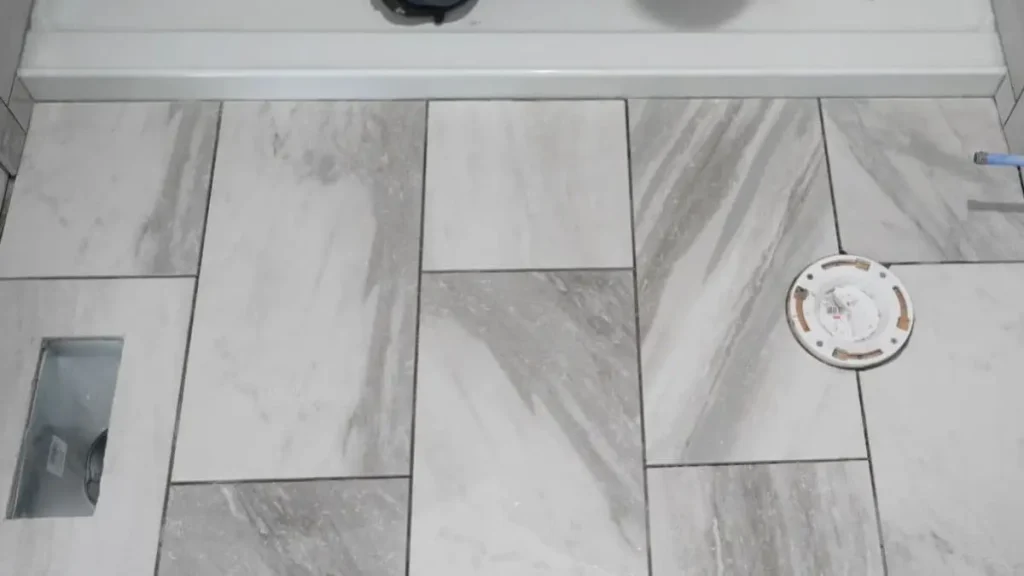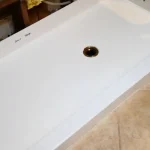To tile around a sloped floor drain, start by applying thin-set mortar and placing tiles to slope towards the drain. Use a level to ensure proper alignment.
Tiling around a sloped floor drain can be a challenging task, but with the right techniques, it can be done effectively. Properly tiling around a sloped floor drain not only enhances the aesthetics of the space but also ensures efficient drainage.
By following the correct steps and using the right materials, you can achieve a professional finish that is both functional and visually appealing. We will provide you with a step-by-step guide on how to tile around a sloped floor drain, helping you achieve a seamless and polished look in your space.
What Is A Sloped Floor Drain?
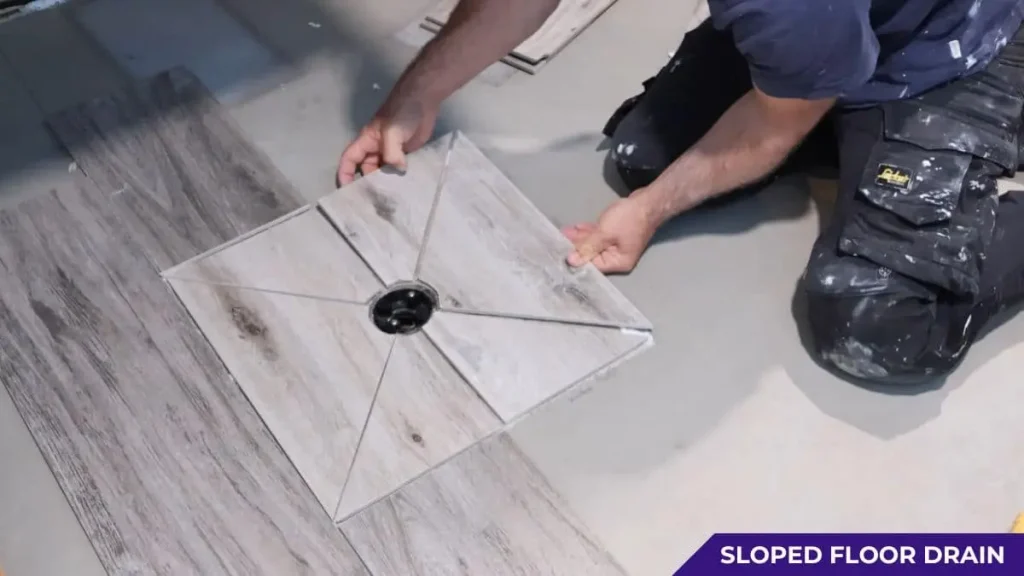
A sloped floor drain is designed to direct water towards the drain, preventing pooling. When tiling around a sloped floor drain, it’s crucial to ensure a seamless transition. Properly measuring and cutting the tiles to fit the slope will result in a smooth and functional finish.
A sloped floor drain is a type of floor drain that is installed on a sloped surface to prevent water from accumulating on the floor. It is commonly found in areas like bathrooms, showers, and basements where water is likely to pool. A sloped floor drain is designed to direct water towards the drain so that it can be removed from the area and prevent water damage to the surrounding surfaces.
Importance Of Proper Tiling
Proper tiling around a sloped floor drain is crucial to prevent water from seeping into the subfloor and causing damage. When water is not properly drained, it can cause mold, mildew, and even structural damage to the building. Additionally, improper tiling around a sloped floor drain can create an uneven surface that can be hazardous to walk on. Therefore, it is important to ensure that the tiling around a sloped floor drain is done correctly to prevent any potential problems.
How To Tile Around A Sloped Floor Drain
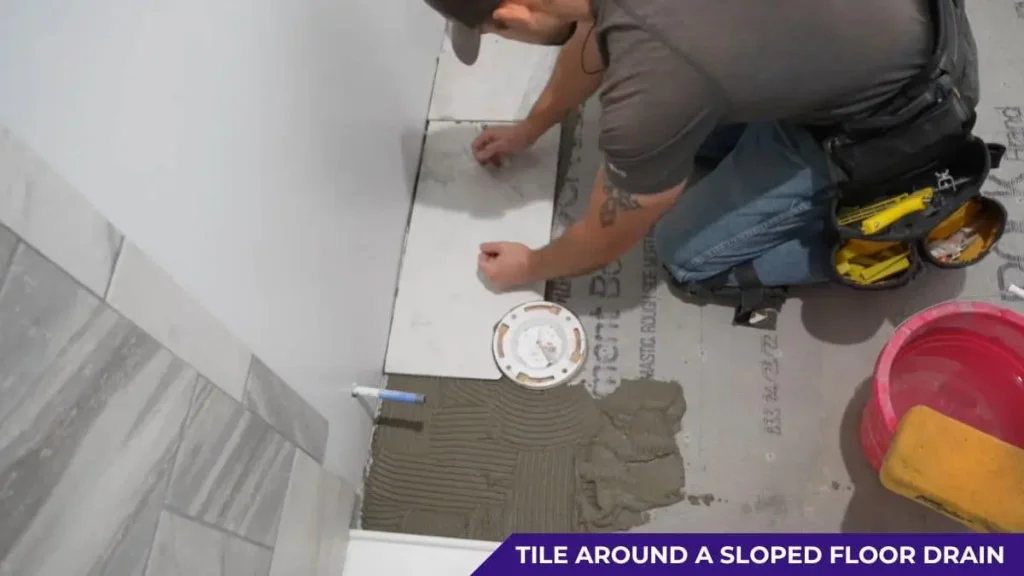
Tiling around a sloped floor drain can be a challenging task, but it is essential to ensure that the area is properly drained. Here are some steps to follow when tiling around a sloped floor drain:
- Start by cleaning the area around the floor drain to ensure that no debris or dirt can interfere with the tiling process.
- Measure the area around the floor drain and cut the tiles to fit the space. It is important to ensure that the tiles are cut to the correct size and shape to prevent any gaps or uneven surfaces.
- Apply the tile adhesive to the area around the floor drain and press the tiles into place. Use spacers to ensure that the tiles are evenly spaced and level.
- Cut the tiles to fit around the edges of the drain and install them using the same process as the other tiles.
- Allow the adhesive to dry for the recommended amount of time before grouting the tiles.
- Apply the grout to the tiles and use a grout float to smooth it into the gaps between the tiles.
- Wipe away any excess grout with a damp sponge and allow the grout to dry for the recommended amount of time.
Recommended Post: How to Install Vinyl Flooring Around a Floor Drain
Assessing The Sloped Floor Drain
Assessing the Sloped Floor Drain is a crucial step when tiling around it. Understanding its function and measuring the slope are essential for a successful tiling project. Let’s delve into these important considerations before diving into the tiling process.
The Drain’s Function
A floor drain is designed to remove any standing water from a specific area, preventing flooding and water damage. It is essential for maintaining a dry and safe environment, especially in areas prone to water accumulation, such as bathrooms, basements, or laundry rooms.
Measuring The Slope
Measuring the slope around the floor drain is crucial to ensure proper drainage. Use a level to determine the direction and degree of the slope, as this will dictate how the tiles should be laid to maintain proper drainage flow.
Essential Tools For Tiling
- Trowel: To spread the adhesive evenly on the floor.
- Tile cutter: For precise cutting of tiles to fit around the drain.
- Grout float: To apply grout between the tiles seamlessly.
- Level: To ensure tiles are laid flat and even on the sloped surface.
Preparing The Floor Surface
Preparing the floor surface is a crucial step in tiling around a sloped floor drain. It ensures a smooth and durable foundation for the tile installation. This process involves cleaning the area and leveling the surface to ensure the tiles lay flat and securely.
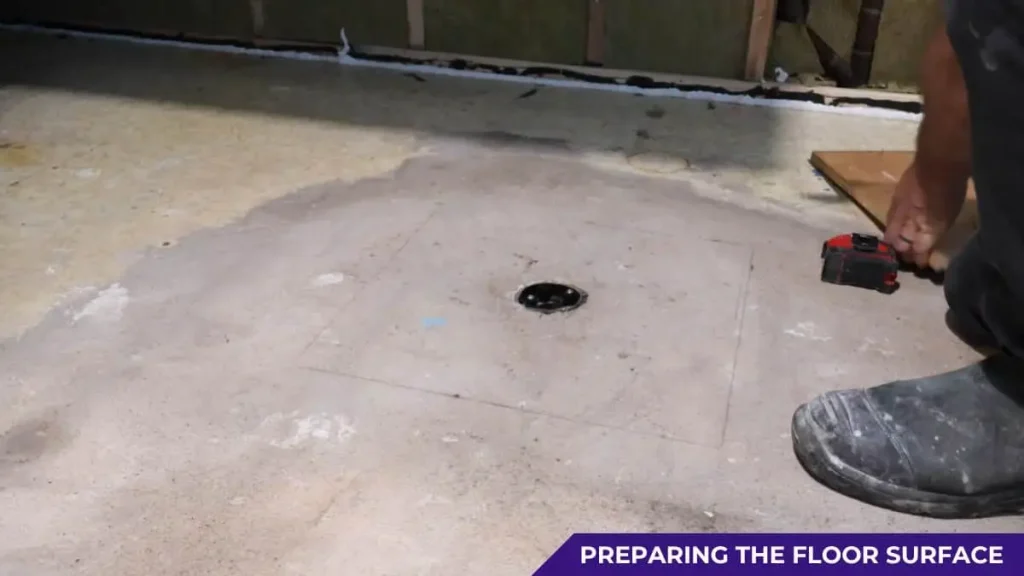
Cleaning The Area
Before tiling, it’s essential to clean the area around the floor drain thoroughly. Remove any debris, dust, or old adhesive to create a clean and smooth surface for the new tiles. Use a vacuum cleaner or a broom to eliminate any loose particles, followed by wiping the area with a damp cloth to ensure it’s free from any residual dirt or grime. This step is crucial for promoting proper adhesion of the new tiles and preventing any imperfections in the finished floor.
Leveling The Surface
After cleaning, the next step is to level the surface around the sloped floor drain. This ensures that the tiles will lay flat and prevent any unevenness in the finished floor. Use a self-leveling compound to fill in any low spots or indentations, following the manufacturer’s instructions carefully. This process will create a smooth and even surface, providing a solid base for the tile installation. It’s crucial to allow the leveling compound to dry completely before proceeding with the tiling process.
Tiling Around The Sloped Floor Drain
When tiling a bathroom or kitchen with a sloped floor drain, it’s important to ensure proper water drainage while maintaining a visually appealing tile layout. Tiling around a sloped floor drain requires careful planning and precise execution to achieve a seamless and professional finish.
Cutting Tiles To Fit The Slope
To accommodate the slope of the floor drain, tiles need to be cut to fit the irregular shape. Measure and mark the tiles according to the slope of the drain, and use a tile cutter or wet saw to make precise cuts. Ensuring a snug fit around the drain is crucial to maintain both the functionality and aesthetics of the tiled area.
Applying The Tiles
When applying the tiles around the sloped floor drain, it’s essential to use a suitable adhesive that can withstand moisture and provide a strong bond. Start by applying adhesive to the back of the tiles and carefully press them into place, ensuring that the edges align neatly with the drain’s slope. Use tile spacers to maintain consistent spacing between the tiles, and make adjustments as necessary to achieve a uniform and visually pleasing layout.
Read Also: How to Install Vinyl Flooring in Bathroom Without Removing the Toilet
Dealing With Grouting And Sealing
Dealing with Grouting and Sealing when tiling around a sloped floor drain is crucial to ensure a watertight and visually appealing finish. Proper grouting and sealing techniques are essential for maintaining the integrity of the tiled area and preventing water damage.
Grouting The Tiled Area
When grouting the tiled area around a sloped floor drain, it’s important to use a high-quality grout that is both waterproof and flexible. Select a grout color that complements the tiles and the overall aesthetic of the space.
- Use a rubber float to spread the grout over the tiled surface, pressing it into the joints to ensure complete coverage.
- Work in small sections to prevent the grout from drying out before you can clean the excess.
- After allowing the grout to set for the specified time, use a damp sponge to wipe away any excess grout from the tile surfaces.
- Regularly rinse the sponge in clean water to ensure a smooth, consistent finish.
Sealing Around The Drain
Sealing around the drain is essential to prevent water from seeping beneath the tiles and causing damage. Select a high-quality waterproof sealant that is specifically designed for use in wet areas.
- Carefully apply the sealant around the edges of the drain, ensuring complete coverage to create a watertight barrier.
- Use a caulking gun for precise application and to control the flow of the sealant.
- Smooth the sealant with a damp cloth to ensure a neat and tidy finish.
- Allow the sealant to cure completely before exposing it to water or foot traffic.
Ensuring Proper Drainage
Ensuring proper drainage around a sloped floor drain is crucial when tiling to prevent water pooling and potential damage. The correct water flow and making necessary adjustments are essential for effective drainage.
Checking Water Flow
Before tiling around a sloped floor drain, ensure that the water flows smoothly towards the drain. Use a level to check the slope, ensuring it angles towards the drain. Additionally, pour water onto the tiled surface and observe the flow towards the drain. If the water pools or flows in the wrong direction, adjustments are necessary.
Making Adjustments If Necessary
If the water does not flow properly towards the drain, adjustments are required. This may involve repositioning the tiles, adding a slight slope to the surrounding tiles, or installing a secondary drain to facilitate proper water drainage. Making these adjustments will ensure the effective drainage of water around the sloped floor drain.
Final Touches And Maintenance
Final Touches and Maintenance are crucial steps in ensuring the longevity and beauty of your tiled surface around a sloped floor drain.
Cleaning The Tiled Surface
Regular cleaning with a mild detergent and water solution keeps your tiled surface looking fresh.
- Avoid harsh chemicals that may damage the tiles or grout.
- Use a soft-bristled brush to scrub away any dirt or grime gently.
Regular Maintenance Tips
Inspect the grout lines periodically for any signs of cracking or deterioration.
- Reapply grout sealant as needed to prevent water seepage.
- Check the slope of the drain to ensure proper water drainage.
Conclusion
To sum up, tiling around a sloped floor drain is a manageable task with the right techniques. By following the steps outlined in this guide, you can successfully navigate this challenge. Remember to take your time, measure accurately, and use quality materials for a professional finish.
Happy tiling!

